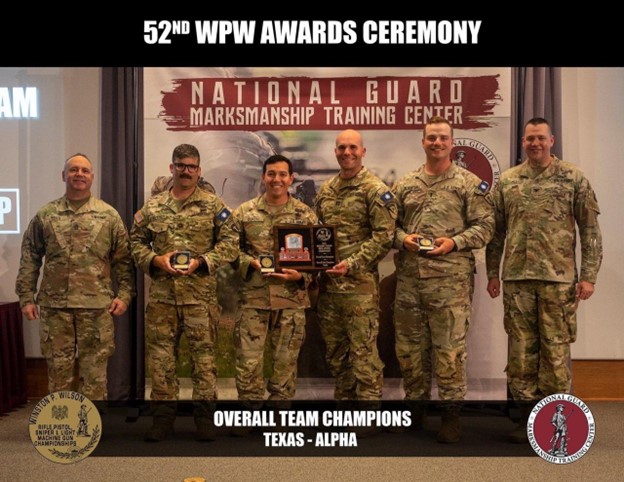 CAMP ROBINSON, Ark. – Four members of the Texas Army National Guard won the 52nd Annual Winston P. Wilson Championship, April 29- May 5, 2023, in Little Rock, Arkansas.
CAMP ROBINSON, Ark. – Four members of the Texas Army National Guard won the 52nd Annual Winston P. Wilson Championship, April 29- May 5, 2023, in Little Rock, Arkansas.
The National Guard hosts the Winston P. Wilson Championship annually to promote marksmanship training. This competition offers National Guardsmen an opportunity to test marksmanship skills and weapon systems in a battle-focused environment.
“Marksmanship is the quintessential skill of a Soldier,” said U.S. Army Col. Kevin Crawford, 176th Engineer Brigade commander. “Having Soldiers of this caliber is a force multiplier to having trained, mission-ready forces. The outcome was fantastic, allowing their world-class performance to take the competition.”
These Soldiers are dedicated to excellence and spend countless hours of their own time mastering their individually assigned weapons, Crawford added.
The Texas Army National Guard team, known as the Texas Alpha Team, was comprised of Sgt. 1st Class Charles Stevener, Sgt. 1st Class Stephen Duron, both from 1st Battalion, 143rd Infantry Regiment, 1st Lt. Samuel Slichter of 386th Engineer Battalion, 176th Engineer Brigade, and Capt. Ross Buntyn of 111st Engineer Battalion, 136th Maneuver Enhancement Brigade. Buntyn served as team captain of the Texas Alpha Team.
Texas Alpha Team took home team awards from the competition including High Overall Team Aggregate and High Overall Rifle Team Aggregate, and numerous individual awards including 1st Place Overall Novice, 1st Place Rifle Novice, 3rd Place Rifle Novice, and 3rd Place Pistol Novice.
“The team was successful due to our consistency –this consistency--regardless of weather conditions, fatigue, time of day, or match format led to our success,” said Slichter. “As a team, we consistently placed around the top 10 and as individuals placed in the top quarter.”
Our consistency is rooted in a firm grasp of the fundamentals of marksmanship, added Slichter.
Established in September of 1971 by Major General Winston P. Wilson, the Chief of the National Guard Bureau, the first rifle and pistol championships took place at Camp Robinson, Ark.
In 2007, the competition was revamped, and new courses of fire were implemented to enhance combat survivability and evaluate the capability of Service Members (SMs) to effectively employ their service weapons.
While basic marksmanship techniques are still an integral part of the competition, a particular emphasis has been put on combat realism, physical exertion and close individual and team coordination.
The Texas Alpha Team competed in 29 different marksmanship challenges during both the day and night, utilizing their M4A1 carbine and M17 service weapons.
The challenges included individual and team events, ranging from close-quarter battle scenarios to long-distance shooting.
The weeklong competition was grueling. The team navigated strong winds, harsh sunlight, exhaustion, and a variety of shooting formats.
“Each member was encouraging and did not allow any setbacks to negatively affect each other's performance,” said Buntyn. “As a team, we meshed very well and played off of each other’s strengths. We did our best to take learning points from each match, maintain a professional attitude, and remained emotionally detached from the outcome, which allowed us to perform consistently.”
This year, 57 four-SM teams representing 43 states and territories participated in the competition. In the end, the Texas Alpha Team was left standing at the top.
“I am very proud of the performance of the Texas Alpha team,” said Buntyn. “The competition at the 2023 WPW was very tough and overall scores were much higher when compared to previous years. It was clear that each state sent their best available competitors.”
The support for this team was instrumental to its success.
The unseen professionals who supported the team made significant contributions in the form of initial planning, WARNO/OPORDs, administration, budgeting, meals, ammunition, range control, logisticians, range support personnel, weapons, and most importantly the support of commanders and families of the participants.
“I must thank Chief Warrant Officer 4 Michael Brown for his support as well as each unit of the members of the team,” said Buntyn. “Without their support, we would not have been able to prepare for and compete in the competition.”
The support the team received enabled the Texas Alpha Team to train without distraction or burden.
“Congratulations to Texas Alpha Team and thank you to the Adjutant General and Texas Military Department for your trust and support of the competitive marksmanship program,” said Brown, team organizer. “The state-level matches start again in January. Texas will need new marksmen that can ‘Come and Take It’.”
As champion marksmen and leaders, Texas Alpha Team will inevitably disperse back to the ranks in positions of increased responsibility and enhance proficiency and lethality of individually assigned weapons, Brown added.
“2023 Winston P. Wilson (WPW) Texas Alpha Team win is truly a Team Texas win,” said Crawford. “Texas Alpha Team is comprised of four carefully selected, high functioning marksmen whose shots inside the “X” ring at WPW will have lasting impacts on marksmanship within the Texas Army National Guard.”